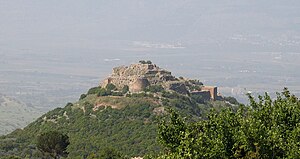Nimrod (castle)
| Nimrodsburg | ||
|---|---|---|
|
Nimrod Castle |
||
| Alternative name (s): | Qala'at al-Subeiba; Subeibé | |
| Creation time : | around 1229 | |
| Castle type : | Rock castle | |
| Conservation status: | ruin | |
| Geographical location | 33 ° 15 '10.1 " N , 35 ° 42' 52.6" E | |
| Height: | 800 m | |
|
|
||
The Nimrodsburg (also Subeibé ; Arabic : Qala'at al-Subeiba , in German "Castle on the big rock"; Hebrew : מבצר נמרוד, Mivtzar Nimrod ) is a medieval fortress from the 13th century, which was built by Saladin's nephew al -Aziz Uthman and is located in the north of the Golan Heights . The fortress is known as one of the national parks in Israel under the name of Nimrod National Park . The park covers almost 20 hectares. The castle name Nimrod originated from a local tradition, which says that Noach's great-grandson , the " first hero on earth and capable hunter " (Gen. 10: 8–9), Nimrod , resided on this rock.
location
The Nimrodsburg lies on a narrow rock ridge at an altitude of 800 meters, 3 km east of one of the three source rivers of the Jordan , the Banyasquelle . It can practically only be reached via road 9898, a side road of route 99, which extends 22 km east to Kirjat Schmona , and route 98, which runs along the Syrian border in the Hermon Mountains 10 km south-west. This mighty castle complex offers a view of the west and south the triangle of Israel, Lebanon and Syria .
The fortress complex is 420 meters long and 150 meters wide. It is built from large cubic stones.
history
It has not been proven that the castle was built by the Crusaders or the Ayyubids . The Nimrod Castle was probably built around 1229 under the Ayyubid emir al-Aziz Uthman , a brother of the Sultan al-Kamil , to prevent an attack by the Fifth Crusade on Damascus . In the following years the facility was expanded several times, mainly under Sultan Baibars I (1260–1277). The castle was used to monitor the road connection from Galilee to Damascus in the narrow valley between the Hermon and the Golan Heights and to protect the city of Banyas . During the strong battles between the Crusaders and the Saracens , the castle often changed hands.
By the end of the 13th century, however, the castle lost its importance, because the influence of the Crusaders was pushed back by the Saracens.
It was not until the Ottomans conquered the country in 1517 that the castle regained a certain importance as a luxurious prison for the Ottoman nobility. After this function was given up in the 16th century, the castle fell into disrepair, only to be completely destroyed by an earthquake in the 18th century .
investment
The Baedeker travel guide “Palestine and Syria” called the Nimrodsburg more than a hundred years ago “ one of the best preserved and greatest castles in Syria ” (1904: 229). At the time, Syria was a cultural landscape dominated by the Ottomans (including today's Israel and Jordan ) was understood.
Today the fortress is administered by the Israeli Nature and Nature Reserves Authority. Visitors can explore the exposed and restored parts of the fortress.
Individual evidence
- ↑ See Kennedy: Crusader castles.
- ↑ Cf. R. Ellenblum: Who built Qal'at al-Subayba? Dumbarton Oaks Papers 43, 1989, pp. 103-12
literature
- Hugh Kennedy: Crusader castles . Cambridge University Press, 1994.
Web links
- National park administration, information about Nimrod Fortress (English)
- Land of the Bible: Qala'at Nimrud


